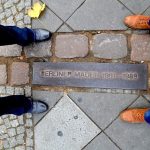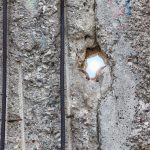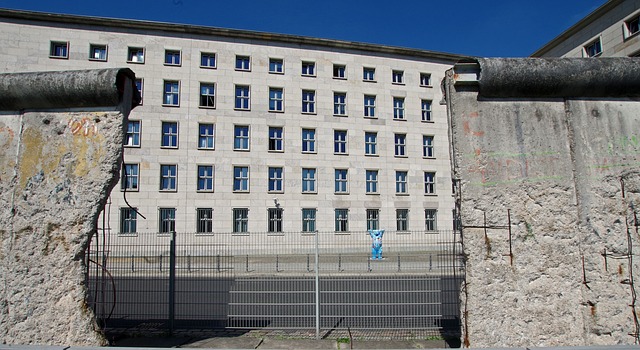
DEUTSCHE WELLE:
When the Wall Fell – From Division to Unity
It is one of the most significant events of the last century: due to the peaceful and courageous pressure of the people, the Berlin Wall falls unexpectedly on the night of 9 to 10 November 1989. Exuberant joy unites thousands at the border crossings and the Brandenburg Gate. For more than 28 years, the notorious structure had separated families, friends and lovers. The German-German division began after the Second World War in 1945, when the Allied states of the USA, the Soviet Union, Great Britain and France divided the defeated Germany into four sectors. But the victorious powers cannot agree on a common future for Germany. The result is a rift between East and West. The Federal Republic of Germany is founded in the three western zones, and the German Democratic Republic in the Soviet occupation zone. Berlin becomes a focal point in the Cold War. When hundreds of thousands of people flee to the Federal Republic of Germany after the founding of the GDR, the inner-German border is secured by fences, guards and alarms from 1952 onwards. Berlin initially remains a loophole. But the GDR is threatened with further “bleeding out” and the state leadership finally gives the order to build the Wall. On 13 August 1961, Berlin is divided within a few hours. GDR propaganda describes the border fortifications as an “anti-fascist protective wall” that is supposed to protect the German Democratic Republic from “migration, espionage, sabotage and aggression from the West”, among other things. Tens of thousands try to flee the socialist GDR during more than 28 years of division. The upheaval in the political situation in the Soviet Union in the mid-1980s brought about profound changes in the GDR. Glasnost” and “perestroika” herald democratic reforms. Hungary and the then Czechoslovakia loosen their borders, the “Iron Curtain” suddenly has a hole. The GDR cannot exist without its hermetically sealed western border. In autumn 1989, on the 40th anniversary of the GDR, unrest and indignation grow among the population. After decades of immobility, the people dared to protest openly. When the GDR leadership finally announced a new travel decree at a press conference on 9 November 1989, there was no stopping at the border crossings. At 10.30 p.m. the barrier is opened at the Bornholmer Straße border crossing. It is one of the most exciting moments in German history, which could have ended quite differently.With the fall of the Wall, the symbol of the division of the world fell. The events of 9 November not only led to the dissolution of the GDR. One year later, Germany was reunited. The Cold War was over. In the documentary “Wie die Mauer fiel – Von der Teilung bis zur Einheit” (How the Wall Fell – From Division to Unity), author Jens Nicolai tells the moving story of the division of Germany and how it was overcome.
Quelle: https://www.dw.com/de/wie-die-mauer-fiel-von-der-teilung-bis-zur-einheit/a-444675202.12.2018
Archiv “Was ist was?”
The Allied Control Council
The occupying powers set up the Allied Control Council as the highest governmental authority in Germany. This consisted of the four supreme commanders of the occupying armies and was to decide jointly and unanimously on all matters affecting Germany as a whole. The objectives set out in the Potsdam Agreement were translated into proclamations, laws and orders, which were then to be implemented in the respective occupation zones. In addition, the Control Council had to suspend the National Socialist laws and decrees. However, increasing mistrust between the Western powers and the Soviet Union paralysed the work of the Control Council. In protest against the recommendations of the London Six-Power Conference and the founding of the “Western Union”, the Soviet military governor Sokolowski left the meeting of the Allied Control Council on 20 March 1948, which subsequently did not meet again. This marked the end of the joint administration by the four victorious powers. The division of Germany became apparent. The Cold War The progressive confrontation between East and West soon took on paranoid features: The West feared that the Soviet Union would seize a united Germany, the Soviet Union was afraid of being pushed back to the Oder. In response to these fears, Germany was divided. However, the onset of the Cold War and the poor economic situation soon forced the Western Allies to cooperate: the British and Americans united their occupation zones to form the Bizone on 1 January 1947. France’s accession then created the Trizone in April 1949. The currency reform in the three western zones on the night of 20-21 June 1948 and the subsequent currency reform in the eastern zone initially completed the division of Germany financially.Important steps towards the final division were the Berlin blockade in 1949 and the founding of the Federal Republic of Germany and the German Democratic Republic in the same year.
Quelle: https://www.wasistwas.de/archiv-geschichte-details/die-teilung-deutschlands.html 02.12.2018
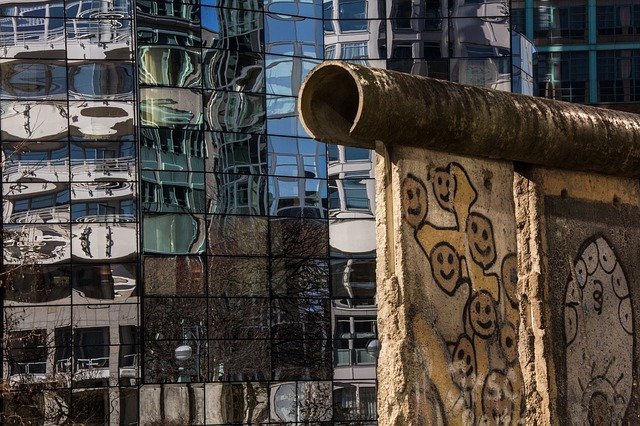
ARTS & CULTURE
The fall of the Wall in 1989 and the creation of the East Side Gallery
After the Peaceful Revolution and the fall of the Berlin Wall on 9 November 1989, the monstrous barrier wall was torn down and was to be removed from the cityscape as quickly as possible. The “Mauerspechte” (Wall Woodpeckers) also played a part in this, working the concrete wall with hammer and chisel and taking the broken-out pieces with them as a triumph over the overcoming of division. Nevertheless, a section of the Berlin Wall more than 1.3 kilometres long remained on Mühlenstraße. At the time, more than a hundred artists from all over the world ensured that the Wall has been preserved in the Berlin cityscape to this day. In December 1989, artists from West Berlin and the GDR presented their idea of turning the “Wall into the largest gallery in the world”. With an official mandate from the GDR Council of Ministers, the “East Side Gallery” project was founded and opened on 28 September 1990. With their individual messages and comments, the artists created a document for the fact that freedom and creativity are ultimately stronger than coercive measures and violence. With more than a hundred paintings, they expressed their joy at the fall of the Wall and the overcoming of division. With their works, the artists of the East Side Gallery saved the Wall from being torn down, from further disintegration and from destruction. In November 1991, the East Side Gallery was entered in the list of monuments of the State of Berlin. The East Side Gallery is not only the most visible result of the opening of the Wall; as a result of the now almost complete demolition of the Berlin Wall, it is also one of the few relics of the border installations that makes the 28-year division of the city perceptible at its original location. Since 1996, many of the artists have been involved in the artists’ initiative East Side Gallery e.V., initiated by Kani Alavi, for the preservation and maintenance of the paintings. Source:https://www.eastsidegalleryberlin.de/ The East Side Gallery is the largest open air gallery in the world. Between February and September 1990, pictures were painted on 1316 metres of the Berlin Wall in East Berlin’s Mühlenstraße. More than 118 artists from 21 countries created 106 unique motifs that spoke of the joy of the fall of the Wall on 9 November 1989 and the end of the Cold War in Europe. In November 1991, these pictures and the remains of the Wall were placed under a preservation order and have since been exposed to the weather and the arbitrariness of visitors. Graffiti, overpaintings, wall break-outs, breakthroughs for building projects, etc. Since 1996, the majority of artists in the East Side Gallery artists’ initiative have been concerned with their preservation. After some local renovations in 1996 (two pictures) and 2000 (40 pictures), the entire wall and the picture motifs were renovated in 2009. For this purpose, all remaining artists were invited to Berlin again to copy their original motifs from 1990 onto the previously renovated Wall. In this way, the East Side Gallery was created once again. The artists are still fighting for its long-term preservation, focusing on the fight against constant graffiti and the threat of new gaps due to new construction projects.
Quellehttps://artsandculture.google.com/exhibit/east-side-gallery/gQAJocMp?hl=de
BERLIN WALL MEMORIAL
Decisions to build the Wall and preparations for closing the border
According to the Czechoslovak defence minister, who defected to the West in 1968, the proposal to erect a barbed wire barrier through Berlin had already been put forward by Ulbricht at the Warsaw Pact meeting in March 1961.11 Ulbricht’s statement at the press conference on 15 June 1961 that no one intended to build a Wall should be understood against this background. The fact that large quantities of building materials such as fence posts and barbed wire were already stored in Berlin in order to realise such barrier measures also points to longer-term planning. Nevertheless, the decision to close the border was taken only just before the decisive day. From 3 to 5 August 1961, a conference of the party leaders of the Warsaw Pact states took place in Moscow, where the problems of the peace treaty and West Berlin were also discussed. Walter Ulbricht was heavily criticised by the comrades for the slow economic growth and high consumer spending in the GDR. Ulbricht reiterated his position that the open border with West Berlin was the cause and demanded that it be sealed off immediately. Khrushchev favoured the peace treaty solution until the end, which in his view should be realised by the end of 1961. However, the Warsaw Pact states feared incalculable economic sanctions in the event of a border closure, which would not only affect the GDR. There were only two options for solving the problem: Complete control of all access routes to West Berlin, including the air corridors – or building the Wall. Since complete control of the air routes was not feasible, the decision to close the border immediately was taken at Ulbricht’s insistence. The central argument for the decision was the explosive economic situation of the GDR and the daily increasing stream of refugees. After Walter Ulbricht returned from the Moscow conference, the Politburo of the SED immediately began to implement the decision taken in Moscow. On 10 and 11 August, the People’s Chamber, the Council of Ministers and the East Berlin Magistrate passed resolutions on the preparation of the border closure, the wording of which was prescribed by the SED. Only the most important comrades in the power corridors were informed in order to keep the planned measures secret for as long as possible. Parallel to the logistical preparations, propaganda was in full swing to prepare the citizens for the drastic measures. For example, at a large event Ulbricht evoked the danger of an attack from the West, against which the GDR had to protect itself. The SED leadership’s aim in closing the border was not to protect GDR citizens from the West, but to prevent free access to West Berlin. The goal was to stabilise the GDR. The main task force was headed by the ZK secretary Erich Honecker. He coordinated the complex procedure for closing the border. An Operative Group was formed at the Ministry of National Defence, which was responsible for carrying out the operation. On the night of 12 August, the SED leadership presented the operational plans to the Soviet diplomats and military. The border police, riot police and company fighting groups were to be deployed to seal off the border. NVA units were to be on standby in the second line to stop an attack from West Berlin in case of emergency. A third security squadron was formed by Soviet troops on the Ring of Berlin. The Ministry for State Security was in charge of the internal political protection of the construction of the Wall. The operation went under the names “Aktion Rose” and “Aktion Ring” and covered the entire territory of the GDR. The results of the intensive observation of the population were to be passed on to the Ministry in hourly reports during the first two days. All cross-border mail was subjected to a check, and telephone traffic to West Germany was to be completely interrupted. The aim was to establish a total surveillance situation.
The sealing off of the border and consequences of building the Wall and consequences of building the Wall and consequences of building the Wall and consequences of building the Wall 12 11 22 12 At 1:00 a.m. on Sunday, 13 August, the systematic sealing off of the 160 km long border around West Berlin began. Members of the People’s and Border Police as well as members of the GDR’s industrial action groups posted themselves along the inner-city demarcation line. The task forces had 30 minutes to block the 81 road crossings. At 1.30 a.m., the railway stations were occupied and local traffic between the two halves of the city was permanently interrupted. Only Friedrichstraße station remained usable as a transfer station for intersectoral traffic. Passenger trains from the west also ended at this station from now on. The pioneering work of closing off the streets had to be done in three hours. The pavement was torn up, track connections separated, Spanish riders erected, barbed wire drawn. By 6.00 a.m., when the city began to wake up, everything was sealed off. Only twelve road connections remained open for the time being, where controlled movement between the city districts was still possible. In the days that followed, they were reduced to eight crossings where strict controls were introduced. On 15 August, two days after the sector borders were sealed off, the GDR’s National Defence Council decided to pioneer the expansion of the border fortifications. During the night of 17 to 18 August, construction crews began to replace the barbed wire barriers with a wall made of hollow blocks and concrete slabs. The construction workers of Berlin were now at the border after all – contrary to Ulbricht’s claims two months earlier – and were deployed to seal off the city once and for all. The Wall became more insurmountable by the day. The inhabitants in East and West were stunned by the situation. Angry and powerless, they faced each other at the barbed wire barriers and the growing Wall. Members of the combat groups and People’s Police officers held the people on the east side at bay with machine guns. Anyone who protested was arrested. On the west side, an agitated crowd gathered. To prevent an escalation of the situation and incalculable developments, the West Berlin police were ordered to keep people away from the border. From one day to the next, the daily life of the city and its inhabitants changed. Tens of thousands of Berlin families were torn apart by the construction of the Wall, lovers separated, friendships destroyed and neighbourhoods ended. Countless people lost their jobs, their livelihoods, their prospects. Indescribable human tragedies took place before the eyes of the world. Wherever it was still possible, people overcame the barbed wire barriers, broke through the barriers with vehicles or jumped out of the border houses into the jump sheets of the West Berlin fire brigade. In September and October, houses directly on the border were forcibly evicted and more than 2,000 residents were driven from their homes. On the inner-German border, too, there were again forced evictions as part of “Aktion Festigung”.
Quelle: https://www.berliner-mauer-gedenkstaette.de/de/uploads/berliner_mauer_dokumente/kurze_geschichte_der_teilung.pdf
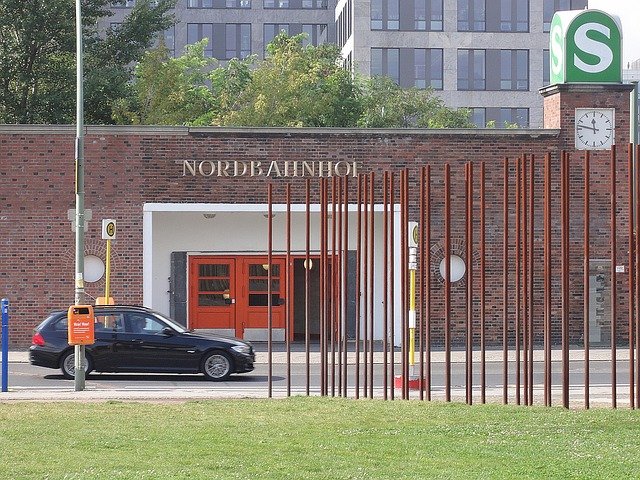
FOCUS.DE
The Berlin Wall – symbol of division
The Berlin Wall was the symbol of German division for more than 28 years. Its construction began on 13 August 1961 – only two months after GDR head of state Walter Ulbricht had assured: “No one intends to build a wall.” It was not until 9 November 1989 that it fell under pressure from the GDR population. Today, only small sections remain. The Wall was built to prevent the economic bleeding of the GDR. Between 1949 and 1961, around 1.6 million people fled to the West through the eye of the needle in Berlin. The GDR propagandistically called the border fortifications the “anti-fascist protective wall”. The inner-German border from the Bay of Lübeck to the then German-Czechoslovakian border near Hof was almost 1,400 kilometres long. The GDR had already begun to erect extensive barriers here in 1952. The wall around the western part of Berlin was 155 kilometres long and almost four metres high. This was also the site of the “death strip” – a 100-metre wide and heavily guarded corridor. Around 11,500 soldiers controlled the border around the divided city. Hundreds of guard dogs and observation towers were supposed to prevent “Republikflucht”. In addition, there were vehicle barrier trenches, anti-personnel mines and self-shooting devices. Despite the massive dangers, GDR citizens repeatedly tried to flee over the Wall to West Berlin. More than 5,000 people are said to have managed to escape. According to the Centre for Contemporary History Potsdam, at least 136 people died at the Wall between 1961 and 1989. The Working Group 13 August assumes that 245 people died at the Berlin border after 1961. How many people actually died at the inner-German border remains unclear. According to State Minister of Culture Bernd Neumann, 1095 suspected cases were identified in a “preliminary study” in 2006.
Quelle:https://www.focus.de/politik/deutschland/geschichte-die-berliner-mauer-symbol-der-teilung_aid_452276.html


